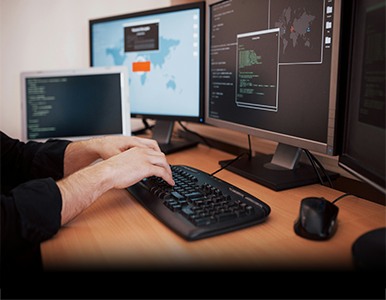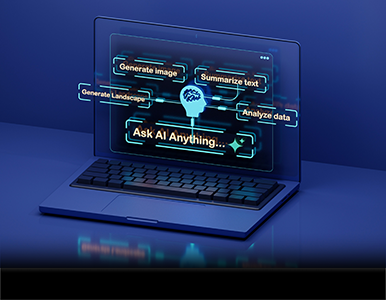Cybersecurity in the Age of AI: Protecting Your Website and User Data

As businesses become more dependent on digital platforms, protecting your website and user data has become crucial. While AI brings innovative solutions for defending against threats, it also introduces new risks. In this article, we’ll explore how AI impacts cybersecurity, common AI-powered cyber threats, best practices for securing your website, and the role of blockchain in cybersecurity.
AI for Threat Detection and Cybersecurity Automation
AI is revolutionising the way we detect and respond to cyber threats. It helps computers understand patterns in data and respond faster than humans can. Here’s how AI is used in cybersecurity :
1. Anomaly Detection
For example, you run an online store, and suddenly, you notice a large number of login attempts from unusual locations. Here, AI systems can instantly detect this and flag it as suspicious. The system can then block these IP addresses before any damage is done.
Check out- AI threat detection tools like Darktrace for more details on anomaly detection.
2. Automated Responses
If a hacker tries to access sensitive customer data, AI can automatically block their access by shutting down the compromised system, all without needing a human to intervene. This quick response helps prevent data breaches.
Check out AI-based cybersecurity platform SentinelOne to learn more about automated response and its features.
3. Predictive Analysis
Think of AI as a weather forecaster for cybersecurity. Just as weather forecasters predict storms based on patterns, AI predicts cyber threats by analysing past attack data. If AI notices certain patterns, it can predict when and where the next attack might happen, allowing your security system to prepare in advance.
Learn more about predictive AI security solutions on CrowdStrike.
This is what Common AI-Powered Cyber Threats look like !
While AI improves security, it also enables new types of cyber-attacks. Let’s look at some of these AI-driven threats :
1. Deepfakes
Imagine seeing a video of a company CEO making an announcement, but it’s actually an AI-generated fake. Cybercriminals use deepfakes to create realistic videos or audio recordings of people saying things they never did. This could be used to trick people into transferring money or sharing sensitive information.
2. Automated Phishing Attacks
Have you ever received an email that looks like it’s from your bank asking you to click a link and confirm your account details? AI allows cybercriminals to create phishing emails that are even more convincing, making it harder to tell they’re fraudulent. These emails can be personalised with your name and other details, making it more likely you’ll click the malicious link.
3. AI Malware
Just like a virus that learns to resist medicine, AI-powered malware can adapt to avoid being detected by security programs. For example, if one part of the malware is detected and blocked, AI might modify it and try a different approach to get through.
Explore AI-based malware detection tools like Cylance for more.
Best Practices for Securing a Website Using AI
Here are some steps businesses can take to secure their website using AI-based tools and solutions:
1. AI-Powered Firewalls
Think of a firewall as a security guard at the entrance of your website. AI-powered firewalls can instantly recognise and block harmful traffic trying to access your website, like malicious bots or hackers. These AI tools analyse traffic patterns and block suspicious activity, all in real-time.
Discover how Cloudflare’s AI-powered firewall protects your website in real-time.
2. AI-Based Authentication
Imagine trying to log in to your online bank account. AI can recognise if you’re logging in from a new device and ask you to confirm your identity. If something seems off, AI may trigger extra layers of security like a text message verification or facial recognition, making it harder for hackers to impersonate you.
Learn more about AI-based authentication solutions from Okta.
3. Continuous Monitoring
Just like a security camera watches over a store, AI-powered monitoring tools continuously keep an eye on your website’s activity. If anything suspicious happens (like an unusually large data download), the AI alerts the security team and may even automatically block the threat.
Explore AI-based website monitoring services like SiteLock.
4. AI for Data Encryption
Encryption is like putting sensitive data in a secure box. AI tools can enhance encryption algorithms, making it even harder for cybercriminals to steal or tamper with data as it moves through the internet.
Learn about AI-enhanced encryption techniques at Vormetric.
The Role of Blockchain in Enhancing Cybersecurity
Blockchain, often associated with cryptocurrencies, is playing a big role in improving cybersecurity. Here’s how :
1. Immutable Data Records
Imagine keeping a record of every transaction made at a store in a public ledger. If someone tries to change a record, everyone can see it. Blockchain works the same way—once data is written into the blockchain, it cannot be altered or tampered with. This makes it much harder for cybercriminals to change important records or steal data.
Read more about blockchain and its impact on cybersecurity at IBM Blockchain.
2. Decentralised Authentication
Instead of relying on one central database to store all user credentials (which is vulnerable to hacking), blockchain allows for decentralised identity management. This means your login details are stored across many different places, making it much harder for attackers to steal all your information at once.
Explore how Sovrin is enabling decentralised identity solutions using blockchain.
3. Smart Contracts for Security Automation
Blockchain can also use smart contracts—self-executing contracts with the terms directly written into code. For example, if a user is trying to access sensitive data, a smart contract can verify their identity and grant access automatically without the need for a middleman. This automated process reduces human errors and increases security.
Learn more about smart contract technology from Ethereum’s official website.
AI is transforming cybersecurity by providing advanced tools to detect threats faster, automate responses, and protect websites and user data. While AI brings incredible advancements in security, it also opens the door for new, more sophisticated threats like deepfakes, automated phishing, and AI malware. By integrating AI-driven tools, continuous monitoring, and adopting practices like blockchain, businesses can stay one step ahead of cybercriminals. The future of cybersecurity is not just about defending against attacks—it’s about using innovative technologies to stay secure in a constantly evolving digital world.
Get in touch with us to discover additional details about the AI services available for your website.


